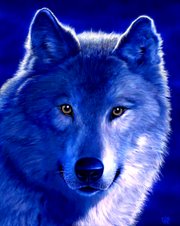
Did We Domesticate Dogs, or Did Dogs Domesticate Us?
A new book by two-time Pulitzer Prize-winning science journalist Jon Franklin concludes that man's best friends may have been responsible for our emergence as the alpha dogs of the animal kingdom.
We wouldn't be who we are without them. So we rewarded them with a lifetime supply of Snausages and Purina Puppy Chow.
Well, it's a little more complicated than that.
Franklin's book, "The Wolf in the Parlor" (Henry Holt, 2009), traces "the eternal connection between humans and dogs" through the millennia. His 20 years of research convinced him that we couldn't have made it without each other.
Dallas critic Bill Marvel calls the author's deductions a stretch. "Franklin seems to suggest that while we were taming the dog, the dog was civilizing us," Marvel wrote. "He reminds me a little of the dyslexic churchgoer who worshipped Dog.
"But biological anthropologist Forrest Smith, a professor emeritus at the University of Akron, isn't troubled at all by the results of Franklin's detective work.
"I agree with him 100 percent," Smith said. Wolves and man were once virtually equals at the top of the predatory food chain, he said. It's logical to believe that the species had to collaborate to survive.
He said it's much the same conclusion that Michael Pollan reached in his book about plant life, "The Omnivore's Dilemma." "Did we domesticate corn or did corn domesticate us?" Smith asked. "We needed each other."
Franklin's book is a blend of emotion and science. Which is a lot like his career. His book "Writing for Story" taught a generation of journalists to bolt past details to the emotional center of the story. Yet he's equally respected among scientists. "I've been carrying around something he wrote about the importance of science for more than 10 years," said Dr. Emilie Clemmens, a professor at Cascadia College near Seattle who has a Ph.D. in bioengineering. "It defines who I am."
In an interview with Sphere, Franklin that he's shown the book to scientist friends and received little resistance to his results or his methods. "Science begins with emotion. Something triggers an emotional response, and then we investigate it."
His emotional response was triggered when he met the love of his life, Lynn, in the late 1980s. "Love me, love my dog," was their unspoken pact.
That's how the descendant of the wolf, a standard poodle named Charlie, came into his parlor.
The marriage and his relationship with Charlie flourished. The feelings that grew toward the dog piqued his scientific curiosity about the link between the species.
A decade earlier he had seen a photograph of the fossilized remains of a man who had been buried with a small dog or wolf cub in what is now Syria some 12,000 years ago. The man was reaching furtively toward the small creature.
Franklin stuck the picture in a drawer until he met Charlie. Two more decades of research led to the book.
Scientists generally agree that the first domesticated dogs appeared around 15,000 years ago, give or take a few dozen centuries. In those days, humans, as they still do, left a mess as they wandered about the planet. Some wolves found it was easier to follow the garbage buffet than to hunt for them.
Dr. Ray Coppinger, an animal behaviorist expert, argued in the book "Dogs" that the wolves began to domesticate themselves as they learned to live around humans. "It was natural selection," he said in the New York Times several years ago. "The dogs did it, not people."
Franklin suggested, though, that humans did play a role in the selection process. Sometimes, the wolf cubs made for a convenient dinner. The cuddly ones were less likely to meet the end of a club.
He noted something else unusual was happening then. The man in the photo's death occurred near the end of the ice age. About the same time, fossils show, the human brain was shrinking by as much as 10 percent. Yet we got smarter. "Suddenly and inexplicably we began to herd, dig, build, draw, plan and invent ... we became uncontested masters of the planet," he wrote.
He believes that our evolutionary dance with the wolves made it all happen. As wolves became dogs -- as the genetic research of Dr. Robert K. Wayne of UCLA has shown -- they herded our flocks. They warned us of nearby predators. They helped us hunt more efficiently. That gave us time to think.
Dogs, Franklin reasons, made us better people.
Just as Charlie nurtured him during their dozen years of walking together. It's a lesson for us all.
"Just remember," Franklin said, "there's an animal on both ends of the leash."
If there is any animal our equal, it is the wolf. I have said this for years, yet, idiots and insecure humans think that they should be hunting and destroying the one creature that probably is responsible for where we are in this time and space on this planet. It never fails, if it can get screwed up, "humans will do it without a doubt".
"Animals, Especially Wolves, Rule",









